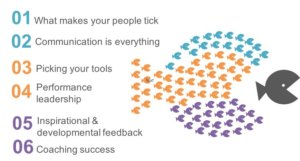
People are silently begging to be led. Whether you lead the business, are a leader of leaders or a leader of people, everyone will be looking to you for direction, for encouragement, and for inspiration. A great leader wins the hearts and minds of their people in order to deliver with passion and commitment, not because they have to, but because they want to. So the key question really is, what do you need to lead others to success?
“The task of the leader is to get his people from where they are to where they have not been.” Henry Kissinger
I Lead Others
I Lead Others is the third & final track of how to develop your leadership capability; I Lead Self and I Lead the Business being the other two key components.

I Lead Others is focused on the leader as the influencer, armed with the knowledge, mindset, and skill set to unlock their peoples’ potential and unleash their success.
A leader who leads others to success knows…
…the precise tools to use on each and every interaction with their people and can give candid and open feedback, both inspirational and developmental.
…when coaching is appropriate when an individual needs tough love, when to simply listen and when to interject.
…that performance management is all about culture, it’s a way of being when building and leading their high performing teams.
…each individual team member is crystal clear on their role, performance criteria and expectations from the business, there are no hidden surprises!
6 key components to lead others to success
What competencies do you need to help your ‘A’ players consistently hit top gear and peak performance?
What skills do you need to nurture, coach and develop your middle 70%,?
What tools do you need to effectively manage the bottom 10%?

#1 Understand what makes your people tick
One of the greatest assets of any business walks out of the door every night. What are you doing to get them to return the next day energised, enthused and motivated to be the best they can be and consistently operating at their peak?
The starting point of leading others to success is about having a fundamental understanding of how we’re wired as humans and what makes us tick. Motivation is a personal choice and your role as a leader is to clearly understand what the driving forces and motivational triggers are of your people. When you know this you can ignite the self-motivation, desire and will in them.
Check out this blog post which explains the 5 interlocking human drivers which are central to understanding what makes your people tick.
#2 Communicate. Communicate. Communicate.
One of the keys to creating a motivational and energising environment for your people is to understand clearly their personal goals and how work can be one of the vehicles in order to help them achieve those goals.
The moment you help create the bridge in their mind – the link between their personal goals and business goals – self-motivation kicks in.
Imagine a triangle; the WHY being at the base, the WHAT on the left side, and the HOW on the right.

We tend to spend most of our time in the WHAT we are doing and the HOW we are doing it but very little time in the WHY we are doing it. The WHY is the foundation of the entire process.
Now imagine the triangle again, adding a horizontal line two-thirds of the way up with the word logic above the line and the word emotion below the line.

In all buying decisions, emotion is far more important than logic. In fact, it is my firm view that all decisions are made emotionally… not logically.
In a world that has become impersonal, where the big things make little difference, it’s the little things which make a big difference.
Personal job satisfaction and motivation are driven by far more than financial factors such as salary and benefits. This can include relocation services, career development, choice of work location, flexibility to spend time with children and attend school functions and sports days.
Every person experiences important moments in their lives, but in business, there is one that stands out above all others: the moment a person changes from someone with a job to someone with a purpose. Whilst the motivation to do so must come from within, the triggers that compel them to make the switch are the ones you can create.
#3 Pick your performance tools
As a leader of others, you have a number of tools available for growing, developing and unlocking the potential in your people. The key to success is knowing when to use each tool depending on where your people are at. Is it attitude, skills or knowledge or combination of all three.
“The growth and development of people is the highest calling of leadership.” Harvey S Firestone
Want to understand the key performance tools at your disposal, check out; 3 core principles for growing and developing your people
#4 Manage and lead through performance
Manage and lead through performance can conjure up both positive and negative meanings in peoples’ minds and ‘performance management’ perhaps are two words that fall into this camp.
For the leader who leads others, performance management is a culture and a way of being when building and leading their high performing teams. But to do this, you must first take stock of your people.
Most people have heard or used Pareto’s 80/20 rule in business development and sales as a tool for analysing which customers contribute to the majority of sales and profits. A second application is for identifying and unlocking your people talent.
Here’s how it works:
20% are top performers, 70% are the heart and soul of your business and 10% are disruptors.

Experience tells me most leaders get drawn into spending a disproportionate amount of time in the 10% category. Just like the bottom 10% of customers in the Pareto sales example who contribute the least profit and are the most problematic, so are the disruptors.
There’s no sugar coating this – most of the time the people who fall into this category are just not right for your business. If you have a business with clear performance expectations and a systematic review process – then the people in the bottom 10% know who they are.
A business has no spare seats and there are no free rides; seats or roles need to be filled with the right people, doing the right things, at the right time, and in the right way.
How to build a pipeline of promising performers is a great blog for helping you fill your seats with the right people.
#5 Use inspirational & developmental feedback
How many leaders can hand on heart say that their people have 100% clarity on how they are performing, what they are doing well and what their developmental areas are?
If they’re being honest with themselves I doubt many can.
If you’re on the fence with how you would fair, your benchmark should be the end of year appraisal with your team members. You see, the end of year appraisal ‘should’ hold no surprises and ‘should’ be the easiest review of the year.

Unfortunately this ‘should’ is often not the reality because giving regular inspirational and developmental feedback often falls to the wayside until a big event happens (positive or negative) which triggers this type of conversation or, it’s all shared in the year-end review.
Time and distance travelled compounds the effects of error so why wait to give feedback? The frequency and timing of feedback are essential. As is the honesty of it. I’m a firm believer of candor in the workplace, check out – candor in the workplace – to find out why.
#6 Coach to success
Leaders who get the most out of their teams spend a high proportion of their time and energy coaching their people.
But what is coaching?
Put simply, it is…
Questioning.
Listening.
Silence.
The key to being a world-class coach is not knowing when to be silent, it’s knowing when to break the silence. Coaching is all about developing the thinking capability of your people, so give them the time to think before you interject with your answer/opinion/comment/follow-up question!
One of the single most competitive advantages for businesses today is their ability to grow, nurture, and develop leadership and management capability faster than the competition…future business success depends on it.
More resources available in my leadership series…
On-demand webinar: ‘How to build a self-sustaining leader-leader culture’
Video: A-Z series of business growth: L=Leadership
Blog:
How to develop your leadership capability


